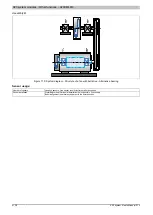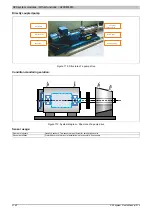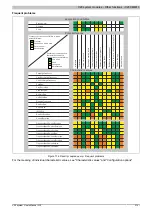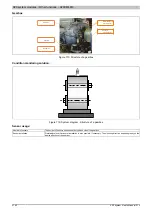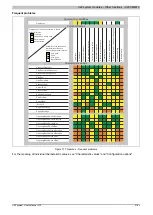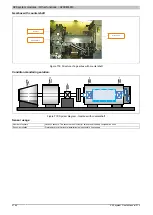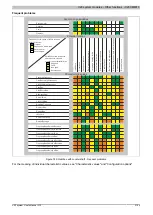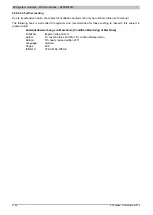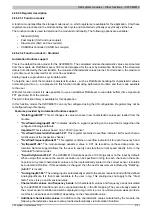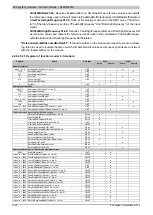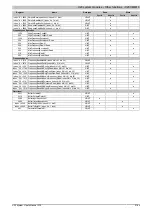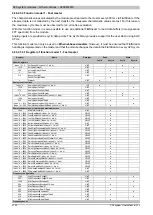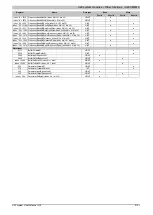
X20 system modules • Other functions • X20CM4810
2152
X20 system User's Manual 3.10
4.26.2.5.4 Function model 2 - Slow master
This function model was developed specifically for operating the X20CM4810 with "slow masters" and for conserv-
ing resources on the PLC.
With this function model, it is not possible to upload data buffers from the module.
Analog inputs are provided as cyclic data points.
Characteristic values are calculated by the module every 300 ms and can only be read via acyclical access. In
order to keep all characteristic values consistent with one another, they can be locked as they are read (Request-
DataLock01). This function model does not allow for seamless measurements, however, although minimum and
maximum functionality can be used for seamless recording. See 4.26.2.5.8 "Module registers - Minimum and max-
imum values" on page 2178
This function model is recommended for all slow buses and masters. It is important to note that asynchronous
register access must be implemented on the master if a B&R master is not being used.
4.26.2.5.4.1 Register of function model 2 - Slow master
Read
Write
Register
Name
Data type
Cyclic
Acyclic
Cyclic
Acyclic
General registers
Index * 2 + 2
ActSpeed0N (Index N = 1 bis 4)
UINT
●
1310
UINT
●
526
UINT
●
0
UINT
●
●
514
UINT
●
0
UINT
●
Analog input functions
Index * 2
AnalogInput0N (Index N = 1 bis 4)
INT
●
1330
UINT
●
570
UINT
●
2
UINT
●
Index * 4 + 22
AnalogInputSamples0N (Index N = 1 bis 4)
UINT
●
1298
UINT
●
546
UINT
●
Index * 4 + 1310 SamplesAnalogInput0N (Index N = 1 bis 4)
UINT
●
Index * 4 + 526 SamplesAnalogInput0NRead (Index N = 1 bis 4)
UINT
●
Characteristic values
Index * 8 + 828 CrestFactorRaw0N (Index N = 1 bis 4)
UDINT
●
Index * 8 + 572 Iso10816_0N (Index N = 1 bis 4)
UDINT
●
Index * 8 + 796 KurtosisRaw0N (Index N = 1 bis 4)
DINT
●
Index * 8 + 732 PeakHighFrequency0N (Index N = 1 bis 4)
UDINT
●
Index * 8 + 924 PeakRaw0N (Index N = 1 bis 4)
UDINT
●
Index * 8 + 668 RmsAccEnvelope0N (Index N = 1 bis 4)
UDINT
●
Index * 8 + 604 RmsAccRaw0N (Index N = 1 bis 4)
UDINT
●
Index * 8 + 764 RmsHighFrequency0N (Index N = 1 bis 4)
UDINT
●
Index * 8 + 982 RmsRaw0N (Index N = 1 bis 4)
UDINT
●
Index * 8 + 700 RmsVelEnvelope0N (Index N = 1 bis 4)
UDINT
●
Index * 8 + 636 RmsVelRaw0N (Index N = 1 bis 4)
UDINT
●
Index * 8 + 860 SkewnessRaw0N (Index N = 1 bis 4)
DINT
●
Characteristic values - minimum and maximum values
2690
UINT
●
Index * 8 + 3588 CrestRawMax0N (Index N = 1 bis 4)
UDINT
●
Index * 8 + 2948 CrestRawMin0N (Index N = 1 bis 4)
UDINT
●
Index * 8 + 3332 Iso10816Max0N (Index N = 1 bis 4)
UDINT
●
Index * 8 + 2692 Iso10816Min0N (Index N = 1 bis 4)
UDINT
●
Index * 8 + 3556 KurtosisRawMax0N (Index N = 1 bis 4)
DINT
●
Index * 8 + 2916 KurtosisRawMin0N (Index N = 1 bis 4)
DINT
●
Index * 8 + 3492 PeakHighFrequencyMax0N (Index N = 1 bis 4)
UDINT
●
Index * 8 + 2852 PeakHighFrequencyMin0N (Index N = 1 bis 4)
UDINT
●
Index * 8 + 3684 PeakRawMax0N (Index N = 1 bis 4)
UDINT
●
Index * 8 + 3044 PeakRawMin0N (Index N = 1 bis 4)
UDINT
●
Index * 8 + 3428 RmsAccEnvelopeMax0N (Index N = 1 bis 4)
UDINT
●
Index * 8 + 2788 RmsAccEnvelopeMin0N (Index N = 1 bis 4)
UDINT
●
Index * 8 + 3364 RmsAccRawMax0N (Index N = 1 bis 4)
UDINT
●
Index * 8 + 2724 RmsAccRawMin0N (Index N = 1 bis 4)
UDINT
●
Index * 8 + 3524 RmsHighFrequencyMax0N (Index N = 1 bis 4)
UDINT
●
Index * 8 + 2884 RmsHighFrequencyMin0N (Index N = 1 bis 4)
UDINT
●
Index * 8 + 3652 RmsRawMax0N (Index N = 1 bis 4)
UDINT
●
Index * 8 + 3012 RmsRawMin0N (Index N = 1 bis 4)
UDINT
●
Summary of Contents for X20 System
Page 2: ......

